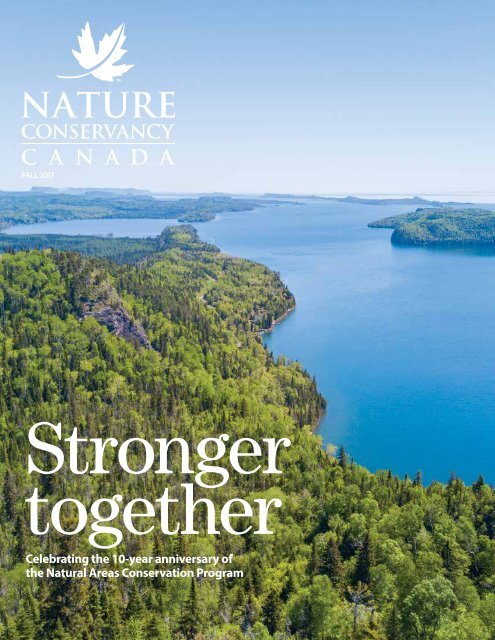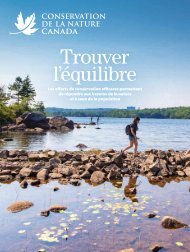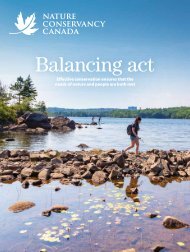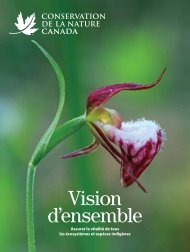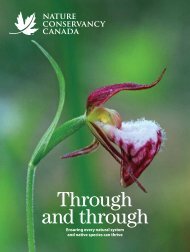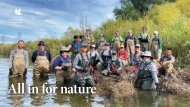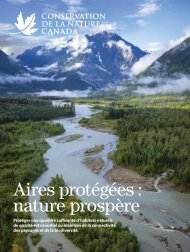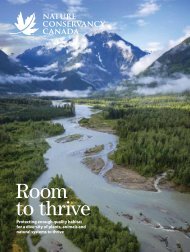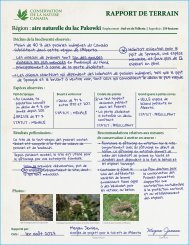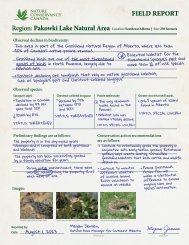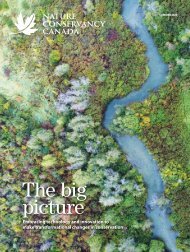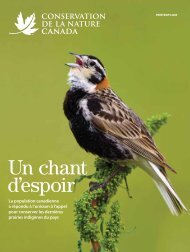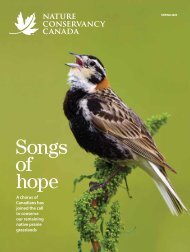NCC's 2017 fall magazine
Create successful ePaper yourself
Turn your PDF publications into a flip-book with our unique Google optimized e-Paper software.
FALL <strong>2017</strong><br />
Stronger<br />
together<br />
Celebrating the 10-year anniversary of<br />
the Natural Areas Conservation Program
Nature Conservancy of Canada<br />
FALL <strong>2017</strong><br />
Nature Conservancy of Canada<br />
245 Eglinton Ave. East, Suite 410<br />
Toronto, Ontario, Canada M4P 3J1<br />
<strong>magazine</strong>@natureconservancy.ca<br />
Phone: 416.932.3202<br />
Toll-free: 800.465.0029<br />
The Nature Conservancy of Canada (NCC)<br />
is the nation’s leading land conservation<br />
organization, working to protect our most<br />
important natural areas and the species<br />
they sustain. Since 1962, NCC and its partners<br />
have helped to protect 2.8 million acres (more<br />
than 1.1 million hectares), coast to coast.<br />
The Nature Conservancy of Canada Magazine is<br />
distributed to donors and supporters of NCC.<br />
TM<br />
Trademarks owned by the Nature Conservancy<br />
of Canada.<br />
FSC is not responsible for any calculations<br />
on saving resources by choosing this paper.<br />
Printed on Rolland Opaque paper, which<br />
contains 30% post-consumer fibre, is<br />
EcoLogo, Processed Chlorine Free certified<br />
and manufactured in Canada by Rolland<br />
using biogas energy. Printed in Canada with<br />
vegetable-based inks by Warrens Waterless<br />
Printing. This publication saved 29 trees and<br />
104,292 litres of water*.<br />
Design by Evermaven.<br />
COVER<br />
Big Trout Bay shoreline, Ontario<br />
Photo by Costal Productions.<br />
THIS PAGE<br />
Big Trout Bay Nature Reserve, Ontario<br />
Photo by Daniel Ehrenworth.<br />
GENERATED BY: CALCULATEUR.ROLLANDINC.COM<br />
*<br />
2 FALL <strong>2017</strong> natureconservancy.ca
Contents<br />
Nature Conservancy of Canada FALL <strong>2017</strong><br />
Better together<br />
TKTKTKTKTKTKT<br />
8: DANIEL EHRENWORTH. 12: TIM ZUROWSKI. 14: THE NATURE TRUST OF BC.<br />
Anew Ipsos MORI poll reports that<br />
Canada currently is the nation<br />
with the most positive influence on<br />
world affairs. As a Canadian, I hate to brag,<br />
but it doesn’t surprise me. We have, in general,<br />
the attitude that we do better — are better<br />
— when we work together. You only need to<br />
think of the response to the devastated<br />
community of Fort McMurray after the fire in<br />
2016; people of all walks of life pulling<br />
together to make life better.<br />
I see this attitude play out every day at the<br />
Nature Conservancy of Canada (NCC). In this<br />
issue of the Nature Conservancy of Canada<br />
Magazine, you’ll read about some of the<br />
people and organizations who have partnered<br />
with NCC through the Natural Areas Conservation<br />
Program (NACP) to help protect<br />
important natural areas. Together, we have<br />
already protected more than 1 million acres<br />
(430,000 hectares) of priority conservation<br />
lands and waters. And there is more to do.<br />
The NACP is built upon strong conservation<br />
science, designed to leverage every dollar<br />
raised and engage partners from the private<br />
and public sectors. The NACP encourages<br />
community conservation, and supports local<br />
donors to care for the places they cherish.<br />
Through the commitment of the Government<br />
of Canada and the dedication of<br />
Canadians from across the country, we are,<br />
yet again, setting an example for the global<br />
community. The message is simple: everyone<br />
has a role to play in conserving the spaces<br />
they love and protecting the places that<br />
sustain us. What part do you want to play?<br />
Yours in conservation,<br />
Lisa McLaughlin<br />
Lisa McLaughlin<br />
NCC vice-president of conservation planning<br />
and policy<br />
8<br />
12<br />
14 Canada’s globally<br />
rare species<br />
Stopping the sixth extinction<br />
starts at home<br />
16 Fairy Hill<br />
This property near Regina, SK, is<br />
sure to delight visitors<br />
17 Nature’s melody<br />
Singer-songwriter Sarah Harmer’s<br />
essentials for exploring nature<br />
14<br />
FEATURE STORY<br />
The power of partnership<br />
Celebrating the 10-year anniversary of the Natural Areas Conservation Program<br />
12 Piping plover<br />
Weighing less than 10 loonies, this small<br />
shorebird is nationally endangered<br />
14 Project updates<br />
Four land trust projects made possible under<br />
the Natural Areas Conservation Program<br />
16 Mike Hendren:<br />
Power of community<br />
How local land trusts can accomplish<br />
significant conservation gains<br />
natureconservancy.ca<br />
FALL <strong>2017</strong> 3
COAST TO<br />
COAST<br />
Putting<br />
our house<br />
in order<br />
Addressing the global species<br />
extinction crisis starts with saving<br />
rare species at home<br />
Canadians often think about the species extinction<br />
crisis as something that is happening elsewhere. The<br />
plight of elephants, tigers and gorillas is well known<br />
to many of us. We absolutely do need to save these<br />
species, but stopping the global extinction crisis needs<br />
to start at home.<br />
Canada is home to approximately 80,000 species.<br />
We know that we were once home to at least 16 species<br />
and sub-species that are now extinct: gone forever<br />
from Canada and gone forever from the planet. Some<br />
species you may have heard of, such as the passenger<br />
pigeon and great auk. The extinction story of others,<br />
such as the Rocky Mountain grasshopper, Macoun’s<br />
shining moss and deepwater cisco, are equally tragic,<br />
but not as well known.<br />
The global status of species is assessed by the<br />
International Union for Conservation of Nature<br />
(IUCN) and maintained on the Red List of Threatened<br />
Species. Currently, Canada has 127 species on the<br />
IUCN Red List. In addition, another 70 species have<br />
been assessed as near threatened, meaning they<br />
are likely to become endangered in the future.<br />
One of the most important results of the Nature<br />
Conservancy of Canada’s (NCC’s) conservation work<br />
is that we are protecting and recovering more than<br />
50 Canadian species that are on the IUCN Red List,<br />
or that have been assessed as near threatened. Many<br />
of these species are on lands that have been secured<br />
over the last 10 years through the Government of<br />
Canada’s Natural Areas Conservation Program.<br />
Here are a few species on the IUCN Red List of<br />
Threatened Species that NCC is helping to protect.1<br />
DEFINING RISK<br />
The International Union for Conservation<br />
of Nature defines the levels of threat on<br />
the Red List as:<br />
• Extinct (EX): No known individuals<br />
remaining.<br />
• Extinct in the wild (EW): Known only<br />
to survive in captivity, or as a naturalized<br />
population outside its historic range.<br />
• Critically endangered (CR): Extremely<br />
high risk of extinction in the wild.<br />
• Endangered (EN): High risk of<br />
extinction in the wild.<br />
• Vulnerable (VU): High risk of<br />
endangerment in the wild.<br />
• Near threatened (NT): Likely to<br />
become endangered in the near future.<br />
• Least concern (LC): Lowest risk.<br />
Does not qualify for a more at-risk<br />
category. Widespread and abundant<br />
taxa (groups of organisms) are included<br />
in this category.<br />
• Data deficient (DD): Not enough<br />
data to make an assessment of its risk<br />
of extinction.<br />
• Not evaluated (NE): Has not yet been<br />
evaluated against the criteria.<br />
When discussing the IUCN Red List, the<br />
official term “threatened” is a grouping<br />
of three categories: critically endangered,<br />
endangered and vulnerable.<br />
READ MORE<br />
Read a blog from NCC’s senior<br />
conservation biologist, Dan Kraus,<br />
with a map of the locations where<br />
NCC has helped protect Red List<br />
species: natureconservancy.ca/<br />
sixthextinction<br />
Dakota skipper,<br />
western prairie<br />
white-fringed orchid<br />
In Manitoba’s tall grass prairie<br />
region, NCC is protecting and<br />
restoring habitat for the western<br />
prairie white-fringed orchid<br />
(endangered) and Dakota skipper<br />
butterfly (vulnerable). In addition<br />
to securing key habitats, NCC<br />
uses prescribed fire as well as<br />
a range of agricultural activities,<br />
such as managed grazing, as<br />
tools to control the intrusion of<br />
woody invasive species and<br />
maintain tall grass habitats.<br />
JACQUI OAKLEY.<br />
4 FALL <strong>2017</strong> natureconservancy.ca
Ram’s-head<br />
lady’s-slipper<br />
NCC has protected<br />
more than 15 properties<br />
that provide habitat<br />
for the ram’s-head<br />
lady’s-slipper (near<br />
threatened) in places<br />
such as the Ottawa Valley<br />
and Bruce Peninsula.<br />
This delicate orchid often<br />
grows in rare habitats,<br />
such as alvars and forested<br />
dunes. NCC staff regularly<br />
monitor the health<br />
of ram’s-head lady’sslipper<br />
populations on<br />
many properties.<br />
Boreal felt lichen<br />
The boreal felt lichen (critically endangered)<br />
needs old-growth coastal forest<br />
to survive. This species once occurred in<br />
Norway and Sweden, but is now extinct<br />
there and can only be found in Atlantic<br />
Canada. NCC has protected habitat for this<br />
rare lichen in Newfoundland and Labrador<br />
and Nova Scotia.<br />
Blanding’s turtle<br />
NCC has protected thousands of acres<br />
of Blanding’s turtle (endangered)<br />
habitat in places such as the Frontenac<br />
Arch in Ontario and the Quebec side of<br />
the Ottawa Valley. Maintaining intact<br />
habitats for the Blanding’s turtle is<br />
critical for its survival because many<br />
females are killed each year on roads<br />
when they migrate to nesting areas.<br />
Semipalmated sandpiper,<br />
piping plover<br />
NCC is protecting key coastal habitats<br />
for two declining shorebirds: piping<br />
plover and semipalmated sandpiper<br />
(both near threatened). NCC protects<br />
important piping plover nesting<br />
habitat in places such as Sandy Point,<br />
Newfoundland and Labrador, and along<br />
Nova Scotia’s South Shore. This bird also<br />
nests in the prairies, including on NCC<br />
properties in Saskatchewan’s Missouri<br />
Coteau. At NCC’s Johnson’s Mills<br />
property in New Brunswick, more than<br />
30 per cent of the world’s population<br />
of semipalmated sandpipers stop to<br />
feed during their migration from mid-July<br />
to mid-September.<br />
Red-headed woodpecker<br />
On Ontario’s Rice Lake Plains, northeast of Toronto,<br />
NCC is protecting rare black oak savannah habitat<br />
that supports the red-headed woodpecker (near<br />
threatened). This colourful bird ranges from<br />
Saskatchewan to Quebec in Canada, and has been<br />
declining by close to three per cent each year since<br />
1966. NCC is also restoring the oak savannahs where<br />
the red-headed woodpecker can be found, through<br />
prescribed burns and invasive species removal.<br />
natureconservancy.ca<br />
FALL <strong>2017</strong> 5
BOOTS ON<br />
THE TRAIL<br />
Wild connections<br />
Just a short drive from Regina, the Fairy Hill South Complex is<br />
a jewel of a property that connects conservation and community<br />
Deer at Fairy Hill<br />
The Fairy Hill South Complex in<br />
Saskatchewan is not just about<br />
the future of wild spaces and<br />
wildlife species, it's also about partnerships<br />
and people.<br />
The Nature Conservancy of Canada’s<br />
(NCC’s) conservation work here means that<br />
this area will be managed in its natural state.<br />
Located just a 30-minute drive north of<br />
Regina on Highway 6, this scenic expanse<br />
of 1,642 acres (665 hectares) of native grasslands,<br />
woodlands, river and floodplains serves<br />
as habitat for aquatic and terrestrial species<br />
and a haven for visitors wishing to enjoy the<br />
area. Fairy Hill is protected for the long term<br />
through NCC’s purchase of the property from<br />
its conservation-minded landowner, Dorothy<br />
Schuurmans, and a generous donation from<br />
Lloyd and Janet Sauer.<br />
Visitors to the property may spot at risk<br />
species, such as loggerhead shrike, northern<br />
leopard frog (prairie population) and Sprague’s<br />
pipit. This area is also well used as a staging site<br />
for ducks and geese and serves as a stopover<br />
for many and varied shorebird species.<br />
A PLACE OF CONNECTION<br />
In addition to its importance as a natural<br />
area, Fairy Hill is a place of connection with<br />
the local community. This summer, local<br />
residents and Conservation Volunteers from<br />
elsewhere in Saskatchewan joined NCC staff<br />
to help remove invasive common burdock and<br />
pull down old fencing.<br />
Given its proximity to Regina, the property<br />
is often used as a place to take school groups<br />
on field trips. School children have come out<br />
here to learn about conservation. They have<br />
also helped NCC staff remove invasive<br />
common burdock from the property.<br />
And thanks to a grazing lease, NCC’s<br />
property is available to a local rancher to<br />
graze his cattle. In return, the cattle help<br />
maintain the health of grasslands on the<br />
property through their grazing.<br />
DANIEL GRUNERT.<br />
6 FALL <strong>2017</strong> natureconservancy.ca
BACKPACK<br />
ESSENTIALS<br />
1<br />
2<br />
Northern leopard frog<br />
A PLACE TO EXPLORE<br />
As you walk through the property, you’ll<br />
weave around native grassland, trees and<br />
wetlands. Follow the loop trail and you will<br />
come to a hill that overlooks the valley. It’s<br />
the perfect spot to have a picnic or just to<br />
pause for a moment.<br />
4<br />
3<br />
ROBERT MCCAW. ESSENTIALS: JUAN LUNA. SARAH HARMER: ANITA DORON.<br />
A PLACE OF HISTORY<br />
Fairy Hill is located in the Qu’Appelle<br />
Valley on Treaty 4 land. It got its name when<br />
Europeans settled the area, as some thought<br />
it reminded them of hills back in Ireland also<br />
called Fairy Hill.<br />
A PLACE OF PARTNERSHIP<br />
A number of partners have been involved in<br />
this conservation project. Various private<br />
and individual contributors have dedicated<br />
funds toward the purchase of Fairy Hill.<br />
In addition, Environment Canada (now<br />
Environment and Climate Change Canada),<br />
through the Natural Areas Conservation<br />
Program, and the Province of Saskatchewan,<br />
through the Fish and Wildlife Development<br />
Fund, have also substantially contributed to<br />
this purchase.<br />
TRAILS<br />
Length: 5 km round-trip<br />
Difficulty: moderate with hills<br />
Terrain: earthen, worn path with<br />
occasional markers<br />
Description: a loop trail passing through<br />
grasslands, forests and wetlands1<br />
NATURE DESTINATIONS<br />
Learn about this Nature Destination at<br />
natureconservancy.ca/fairyhill<br />
5<br />
Nature’s melody<br />
Canadian singer-songwriter Sarah Harmer shares<br />
a few of the essentials she always packs when she’s<br />
out exploring nature<br />
1. JOURNAL When you’re<br />
hanging out with the trees<br />
and appreciating all they<br />
do for us, it’s nice to<br />
know your journal isn’t<br />
made of old-growth<br />
forests...I look for<br />
paper that’s recycled or<br />
FSC (Forest Stewardship<br />
Council) certified.<br />
2. BINOCULARS<br />
My Skipper 7x50 binoculars by Swift<br />
are heavy but strong, and they’ve been<br />
with me since I picked them up at a thrift<br />
shop years ago.<br />
3. WATER BOTTLE<br />
Water is truly the<br />
most essential thing,<br />
especially on a hike.<br />
4. HAT This bright<br />
hat is key in the <strong>fall</strong>,<br />
when hunters may<br />
be out in the woods.<br />
Staying alive and<br />
unharmed is also<br />
clearly essential.<br />
5. PENS A few good pens are a must,<br />
perhaps to sketch a leaf or write down<br />
an idea that strikes.1<br />
natureconservancy.ca<br />
FALL <strong>2017</strong> 7
THE<br />
Power<br />
OF<br />
partnership<br />
This year marks the 10-year anniversary of the<br />
Natural Areas Conservation Program — a unique public-private partnership<br />
that has spurred private land conservation in Canada to new heights<br />
TKTKTKTKTKTKT<br />
8 FALL <strong>2017</strong> natureconservancy.ca
The North Shore of Lake Superior,<br />
renowned for its rugged beauty,<br />
needs little introduction. But that’s<br />
not stopping Gary Davies.<br />
“I think you’re going to have a few ‘Wow!’<br />
moments when you’re on the property,” says the<br />
Nature Conservancy of Canada (NCC) program<br />
director for northwestern Ontario. “It’s got some<br />
pretty spectacular scenery and views.”<br />
The property in question is the Big Trout Bay<br />
Nature Reserve, a 2,500-acre (1,012-hectare)<br />
tract of forest, wetlands, tall cliffs and jagged<br />
peninsulas. It features 21 kilometres of frontage<br />
on the Lake Superior shore and is home to such<br />
iconic species as moose, black bear, Canada<br />
lynx, bald eagle and peregrine falcon, the latter<br />
a species of special concern in Canada.<br />
Purchased by NCC in August 2016, with a<br />
total project cost of $8.5 million — combining<br />
a $3-million contribution from the Government<br />
of Canada’s Natural Areas Conservation<br />
Program (NACP) with matching funds<br />
raised from foundations and private donors<br />
— Big Trout Bay stands as one of the last<br />
undeveloped parcels of Great Lakes coastal<br />
wilderness between Thunder Bay, Ontario,<br />
and Duluth, Minnesota. According to NCC<br />
vice-president of conservation planning and<br />
policy, Lisa McLaughlin, it’s also a hallmark<br />
of the kind of conservation successes made<br />
possible by the NACP — through which NCC<br />
has conserved more than 1 million acres<br />
(430,000 hectares) since the program’s<br />
inception 10 years ago.<br />
TKTKTKTKTKTKT<br />
BY Brian Banks, freelance writer & journalist PHOTOGRAPHY Daniel Ehrenworth<br />
natureconservancy.ca<br />
FALL <strong>2017</strong> 9
Today, Davies is standing near the reserve’s<br />
western boundary, speaking to a group of<br />
wildlife scientists from the Royal Ontario<br />
Museum and the Ontario Ministry of Natural<br />
Resources and Forestry’s Natural Heritage<br />
Information Centre. Scenery aside, it’s the sort<br />
of group whose “Wow!” moments might also<br />
include seeing rare plants, birds or insects.<br />
They’re here to start a week-long intense<br />
science “bioblitz” on the property — one of 10<br />
national science surveys of species biodiversity<br />
held this year under the Canada BioBlitz 150<br />
program — and Davies is outlining features,<br />
access points and hazards to get them oriented.<br />
“There are some pretty steep cliffs,” he warns.<br />
“You’re bushwhacking and then all of a sudden<br />
you’re at the edge.”<br />
Ordinarily, when NCC acquires a new<br />
property, it conducts its own baseline inventory<br />
of plant and animal species. It combines<br />
that data with its existing site knowledge to<br />
create a long-term management plan. It’s no<br />
wonder then that Davies is thrilled to have the<br />
bioblitz team on hand. The pending treasure<br />
trove of data, he says, will be “a baseline<br />
inventory on steroids.”<br />
NCC program director for northwestern<br />
Ontario, Gary Davies, says the NACP was<br />
a significant enabler for the securement<br />
of Big Trout Bay.<br />
In terms of sheer volume of lands conserved, the<br />
more than 1 million acres saved to date under<br />
the NACP represents nearly one-third of the entire<br />
habitat NCC has helped protect since it was<br />
founded in 1962.<br />
Sharing the wealth<br />
Just as the bioblitz has the potential to<br />
kick-start NCC’s work on Big Trout Bay, it<br />
helps to think of the NACP in the same way.<br />
In the past decade, NCC has used the NACP,<br />
with the participation of Ducks Unlimited<br />
Canada and other land trusts, to spur private<br />
land conservation in Canada to a level that<br />
would have been hard to imagine prior to the<br />
creation of the program.<br />
In terms of sheer volume of lands conserved,<br />
the more than 1 million acres saved<br />
to date under the NACP represents nearly<br />
one-third of the entire habitat NCC has<br />
helped protect since it was founded in 1962.<br />
“We have hundreds of thousands of acres<br />
now protected that certainly would not<br />
have happened had this program not been<br />
in place,” says McLaughlin.<br />
The program is about more than raw totals,<br />
however. From day one, when the Government<br />
of Canada put up an initial $225 million<br />
in a fund to be administered by NCC, with<br />
$25 million tabbed for Ducks Unlimited and<br />
another $15 million set aside for other land<br />
trusts, rules required that no money could be<br />
drawn unless it was matched 1:1 with monies<br />
(or an equivalent value in donated property)<br />
raised from other sources — chiefly foundations,<br />
corporations and individual donors. In<br />
2013, when the government allocated another<br />
$100 million to the NACP — money slated to<br />
sustain the program through 2019 — it changed<br />
the ratio to 2:1, doubling the required match<br />
from other sources.<br />
Canada’s Minister of Environment and<br />
Climate Change, Catherine McKenna, believes<br />
the matched funding commitment is key to<br />
the NACP’s success. “It shows it’s not just<br />
government spending the money but working<br />
with great folks like farmers and ranchers,<br />
who are giving land and providing funding for<br />
the program.”<br />
The matching element means every<br />
acquisition done under the NACP is a partnership,<br />
says McLaughlin. “It reinforces the notion<br />
that land conservation or biodiversity conservation<br />
is everyone’s responsibility.” It also<br />
makes it easier to raise funds when you can tell<br />
a donor that every dollar they contribute will<br />
be matched, essentially tripling their impact.<br />
“It was a very significant enabler for us [with<br />
Big Trout Bay],” says Davies.<br />
10 FALL <strong>2017</strong> natureconservancy.ca
In Big Trout Bay’s case, this match even<br />
helped to motivate a number of American<br />
donors and partners, including The Conservation<br />
Fund, a national conservation lender, and<br />
the Minnesota and Wisconsin state chapters of<br />
The Nature Conservancy (U.S.). “They all spoke<br />
to Lake Superior as an international conservation<br />
asset,” Davies says. “It was great to see that<br />
kind of generous cross-border co-operation.”<br />
On many projects, NCC has to seek out<br />
its funding partners. In other instances, they<br />
reach out from the grassroots up.<br />
A clear example in the latter category is<br />
NCC’s Musquash Estuary project, the organization’s<br />
largest reserve in Atlantic Canada, located<br />
less than 20 kilometres southwest of Saint John,<br />
New Brunswick. A sublime, verdant, winding<br />
expanse of salt marshes, peat bogs, tidal flats<br />
and surrounding Acadian forest and freshwater<br />
wetlands, Musquash is one of the last fully<br />
functioning estuaries in the Bay of Fundy, a<br />
haven for aquatic species, migratory water birds<br />
and other wildlife. In 2007, the Musquash Estuary<br />
was announced as Canada’s sixth Marine<br />
Protected Area (MPA) under the Oceans Act.<br />
NCC’s involvement here dates from around<br />
2000, when local residents began campaigning<br />
for the MPA designation in order to protect the<br />
estuary from proposed industrial development.<br />
As the MPA designation only applies to marine<br />
areas, they sought NCC’s assistance in securing<br />
the land around the estuary. By the time the<br />
MPA was designated, NCC had acquired close<br />
to 3,000 acres (1,200 hectares) of adjacent<br />
property, much of it transferred from the<br />
provincial government. That milestone also<br />
coincided with the introduction of the NACP.<br />
In the decade since the program’s introduction,<br />
NCC has relied heavily on the program to secure<br />
another 2,000 acres (800 hectares) on the<br />
estuary. “Much of what’s happened since 2007<br />
has been land donated by local families,” says<br />
Paula Noel, NCC’s New Brunswick program<br />
director. “They’ve given their land, and on<br />
the basis of its matching value, the NACP has<br />
covered the other costs of us being able to accept<br />
that land — such as biological inventories and<br />
gathering information on species and habitat.”<br />
Musquash has also taken on added significance<br />
lately, as the federal government has<br />
stepped up its efforts to deliver on Canada’s<br />
commitments as a party to the Convention on<br />
Biological Diversity (CBD). Under the CBD,<br />
signatories have committed to conserving at<br />
least 17 per cent of terrestrial areas and inland<br />
water, and 10 per cent of coastal and marine<br />
areas, through networks of protected areas<br />
and other effective area-based conservation<br />
measures by 2020. “I think they’re looking at<br />
Musquash as an example of how MPAs should be<br />
done,” says Noel. “Because of all the community<br />
input that was behind that designation.”<br />
The government’s efforts to reach the CBD<br />
targets <strong>fall</strong> under a program called The Pathway<br />
to Canada Target 1 (the language is adapted from<br />
the CBD’s Aichi Biodiversity Targets process).<br />
...continued on page 18<br />
A discussion with<br />
Catherine McKenna,<br />
Minister of<br />
Environment and<br />
Climate Change<br />
BB: This year, NCC is celebrating<br />
the 10-year anniversary of the<br />
NACP. What is your sense of the<br />
NACP’s key accomplishments?<br />
CM: I believe that it’s important<br />
to have public-private sector<br />
partnerships and that’s exactly<br />
what [the NACP] is. It takes real<br />
action to protect lands. And<br />
between 2007 and 2016, [the<br />
program helped conserve] 430,000<br />
hectares of not just any lands, but<br />
ecologically sensitive lands. [We<br />
predict that] by 2019 it’s going to<br />
be well over 500,000 hectares.<br />
It’s really about protecting lands<br />
that people care about. You’re<br />
connecting people to pieces of<br />
land, you’re engaging people<br />
and getting them excited and<br />
motivated to do this and be part<br />
of a bigger picture. It’s not just<br />
environmentalists. You have<br />
ranchers and farmers all coming<br />
together with the federal<br />
government and with the<br />
provinces to protect really<br />
important pieces of land.<br />
Canadians really understand<br />
that it’s critically important that<br />
we protect our natural beauty<br />
and that’s something that’s<br />
broadly shared by Canadians<br />
across the country, of different<br />
political persuasions.<br />
Read the expanded Q&A<br />
with the minister at:<br />
natureconservancy.ca/<br />
catherinemckenna<br />
The week-long bioblitz at Big Trout Bay was an opportunity to gather important<br />
data that will be used to inform a long-term management plan for the property.<br />
Read about the bioblitz<br />
and its findings:<br />
natureconservancy.ca/<br />
btbbioblitz<br />
natureconservancy.ca<br />
FALL <strong>2017</strong> 11
SPECIES<br />
PROFILE<br />
Coastal<br />
camouflage<br />
Blending in with the beaches on which they nest and rear their young, the piping plover’s<br />
sensitivity to habitat loss and shoreline disturbances makes it a nationally endangered species<br />
TIM ZUROWSKI<br />
12 FALL <strong>2017</strong><br />
natureconservancy.ca
What’s black, white and brown, and endangered all<br />
over? If you guessed a small shorebird native to<br />
North America called a piping plover, you’re right.<br />
Piping plovers are migratory shorebirds weighing approximately<br />
43–63 grams (less than 10 loonies). They can be distinguished by<br />
their short, black-tipped orange beak and orange legs.<br />
A SPECIES IN DANGER<br />
Due to disturbances on the shores where they nest, piping plover populations have<br />
been decreasing in Canada (where the species is considered endangered).<br />
Piping plovers nest on beaches during the spring and summer, which is also peak<br />
season for beachgoers. If disturbed by humans or dogs, a piping plover will often<br />
abandon its nest.<br />
Piping plovers rely on camouflage to keep their eggs and chicks safe, nesting on<br />
sandy beaches mixed with gravel or sticks to help conceal themselves. But nesting<br />
in open areas is risky, as they are vulnerable to predators, such as feral cats, foxes<br />
and gulls. Storm surges and high tides can also destroy nests and chicks.<br />
THE PLOVERS OF THE PRAIRIES<br />
While piping plovers may be thought of as coastal shorebirds, 20 per cent of the<br />
world’s population nest in Canada’s prairies, around the edges of lakes.<br />
Canada’s prairies support more than 1,000 piping plovers, mostly in Saskatchewan.<br />
In addition to conserving plover habitat, the Nature Conservancy of Canada<br />
(NCC) participates in the International Piping Plover Census (which happens every<br />
five years) by providing data collected by NCC staff and Conservation Volunteers.<br />
In Saskatchewan, NCC has installed fences around nesting sites, adjusted the<br />
density of grazing livestock and delayed grazing until after nesting season. Staff<br />
from NCC’s Saskatchewan Region have been surveying piping plovers at the Shoe<br />
Lake West property since the International Census began in 1991. This past June,<br />
staff observed up to 12 adults, including three breeding pairs, plus a single chick.<br />
GREAT LAKES COMEBACK<br />
Although rare in Ontario, piping plovers are known to breed at Lake of the<br />
Woods in the western portion of the province, and along the shores of the Great<br />
Lakes, where they are making a remarkable comeback. In the 1980s, the Great<br />
Lakes population was almost extirpated and piping plovers were considered<br />
endangered in Ontario.<br />
Thanks to habitat protection measures and beach stewardship, piping plovers<br />
are recovering and have now bred in Ontario at several locations along Lake Ontario<br />
and Lake Huron. NCC has protected several key coastal areas along the Great Lakes<br />
that could provide nesting habitat for piping plovers as they continue to recover.<br />
EAST COAST LIFESTYLE<br />
In New Brunswick, NCC has conserved nesting habitat for piping plovers at<br />
Miscou Island on the Acadian Peninsula and Tabusintac, in the northern part of<br />
the province.<br />
In Nova Scotia, there are fewer than 40 breeding pairs; a decline of more than<br />
25 per cent since 2001. To help combat this decline, NCC has conserved four properties<br />
with, or adjacent to, piping plover nesting beaches.<br />
At Port Joli, on Nova Scotia’s South Shore, NCC has conserved sensitive and<br />
unique shoreline. Thanks to signs and barriers installed by NCC, beachgoers know<br />
to keep away from active nests.<br />
FACT SHEET<br />
SCIENTIFIC NAME<br />
Charadrius melodus<br />
SIZE AND WEIGHT<br />
This small shorebird measures 17-18 centimetres<br />
in length and can weight up to 63 grams.<br />
RANGE<br />
The Atlantic subspecies (Charadrius melodus<br />
melodus) nests along the Atlantic coast, from<br />
Newfoundland to South Carolina. In Canada,<br />
the species breeds along the coasts of the<br />
four Atlantic provinces and on Quebec’s<br />
Magdalen Islands. The interior subspecies<br />
(Charadrius melodus circumcinctus) nests<br />
on the Great Lakes, Lake of the Woods and<br />
in the southern part of the prairies.<br />
POPULATION TREND<br />
Piping plover populations have been steadily<br />
decreasing in Canada.<br />
STATUS IN CANADA<br />
Endangered<br />
Piping plover range<br />
Interior subspecies (C. m. circumcinctus)<br />
• Atlantic subspecies (C. m. melodus)<br />
NCC works with the New Brunswick<br />
Department of Natural Resources, Bird<br />
Studies Canada’s Piping Plover Guardian<br />
Program and others to ensure that migratory<br />
birds continue to grace the shores of<br />
Atlantic Canada.<br />
Each year, NCC holds Conservation<br />
Volunteers events across the country to<br />
restore areas where piping plovers are known<br />
to nest. Beach cleanups aim to clear away<br />
marine garbage that has washed up on shore<br />
and that might impede the plovers’ nesting.1<br />
natureconservancy.ca<br />
FALL <strong>2017</strong> 13
PROJECT<br />
UPDATES<br />
1<br />
Strategic securement<br />
EAST KOOTENAY, BRITISH COLUMBIA<br />
1<br />
2<br />
Partners in conservation<br />
The Natural Areas Conservation Program also provides<br />
funding for projects by Ducks Unlimited Canada. An additional<br />
$5 million is available to help Canada’s land trusts to<br />
support conservation in their communities under the Other<br />
Qualified Organizations (OQO) portion of the program.<br />
natureconservancy.ca/oqo<br />
3<br />
4<br />
This 170-acre (70-hectare) property<br />
in the East Kootenay, secured by The<br />
Nature Trust of British Columbia<br />
with funding under the Other Qualified<br />
Organizations (OQO) program,<br />
BC<br />
is located 1.5 kilometres north of the<br />
confluence of the Bull and Kootenay<br />
rivers. It provides an important<br />
grassland and open forest corridor<br />
that links Crown lands on both the<br />
north and south sides of the property.<br />
The securement of this property reduces the risk<br />
of disease transmission from domestic livestock to bighorn<br />
sheep, protects the winter range for elk and deer and<br />
protects habitat for endangered American badgers.<br />
“This property is an exciting addition to existing<br />
conservation lands in the lower Bull River,” says Jasper<br />
Lament, CEO of The Nature Trust of BC. “Bighorn sheep<br />
use this property as part of their traditional winter range.<br />
Because it is bounded on three sides by other conservation<br />
lands, it is a very strategically important acquisition.”<br />
The Bull River Corridor, secured with funding under the OQO, provides an important<br />
wilderness corridor and habitat for animals such as elk, deer and bighorn sheep.<br />
MINDEN. THE NATURE TRUST OF BC.<br />
14 FALL <strong>2017</strong><br />
natureconservancy.ca
The Noloqonokek/Nələkwənəkek Nature Preserve is part of the Grand Lake Meadows,<br />
Atlantic Canada’s largest freshwater wetland complex (12,360 acres/5,000 hectares).<br />
ON<br />
SASK.<br />
NB<br />
MINDEN. NATURE TRUST OF NEW BRUNSWICK.<br />
2 Worthy<br />
3 An at-risk<br />
4<br />
wetlands<br />
BUSHFIELD CONSERVA-<br />
TION EASEMENT,<br />
SASKATCHEWAN<br />
Located about 50 kilometres south<br />
of Saskatoon are the rolling Allan<br />
Hills. Because of the high density<br />
of wetlands, the area supports as<br />
many as 60 breeding waterfowl<br />
pairs per square mile, including<br />
up to 10 pairs of northern pintails<br />
— a species that has declined<br />
by more than 70 per cent between<br />
1966-2012 in North America.<br />
Agricultural and municipal<br />
development pressures have<br />
had an impact on wetlands in<br />
the Allan Hills area. Thankfully,<br />
Ducks Unlimited Canada (DUC),<br />
along with some very mindful<br />
farmers, recently announced a<br />
conservation project in the area.<br />
The Bushfield conservation<br />
easement will add another 3,000<br />
acres (1,200 hectares) of conserved<br />
wetlands and grasslands<br />
in the Allan Hills.<br />
DUC has been a valuable<br />
and effective partner since the<br />
inception of the NACP. Under the<br />
NACP, DUC has conserved more<br />
than 158,150 acres (64,000 hectares)<br />
on 569 projects since 2007.<br />
watershed<br />
SYDENHAM RIVER,<br />
ONTARIO<br />
Secured by Ontario Nature with<br />
support from the OQO program,<br />
this 190-acre (80-hectare) property<br />
provides important habitat for<br />
wildlife in a watershed where<br />
more than 85 per cent of the land<br />
is crops. The property protects<br />
a section of the main branch of<br />
the Sydenham River, floodplains<br />
and forests dominated by sugar<br />
maple and American beech.<br />
The Sydenham River is<br />
well-known for its richness of<br />
aquatic species and contains the<br />
greatest diversity of freshwater<br />
mussel species of any watershed<br />
in Canada. Over 10 aquatic species<br />
at risk have been documented on<br />
the property, including eastern<br />
sand darter, blackstripe topminnow<br />
and salamander mussel. The<br />
section of river on the property<br />
is one of only three places in<br />
the world where the northern<br />
riffleshell mussel is healthy and<br />
reproducing. Other species at<br />
risk found on the property<br />
include cerulean warbler,<br />
red-headed woodpecker, blue<br />
ash and Kentucky coffee-tree.<br />
Freshwater<br />
diversity<br />
MIDDLE ISLAND,<br />
NEW BRUNSWICK<br />
The Noloqonokek/Nələkwənəkek<br />
Nature Preserve, located on<br />
Middle Island in the Maugerville<br />
area of the lower St. John River,<br />
was named after the traditional<br />
Wolastoqiyik/Wəlastəkwiyik<br />
name for the island. Thanks to<br />
funding contributions under<br />
the OQO program, the Nature<br />
Trust of New Brunswick acquired<br />
the new 170-acre (70-hectare)<br />
nature preserve to conserve its<br />
floodplain forest and provincially<br />
significant wetlands. The wetlands<br />
and shores support a diversity<br />
of plants, birds, amphibians and<br />
aquatic species — including the<br />
globally rare yellow lampmussel<br />
and tidewater mucket.<br />
Located two kilometres south<br />
of the 5,300-acre (2,150-hectare)<br />
Portobello Creek National<br />
Wildlife Area, established in<br />
1995, the conservation of Middle<br />
Island now secures the rich<br />
habitat in close proximity to this<br />
national wildlife area for the<br />
long term.1<br />
Partner<br />
Spotlight<br />
This year, the Nature<br />
Conservancy of Canada<br />
presents NatureTalks,<br />
a Canada-wide speaker series.<br />
NatureTalks is an evening of<br />
thought-provoking content, led<br />
by a diverse panel of experts. The<br />
events encourage communities<br />
to come together to explore and<br />
discuss nature as a resource,<br />
an inspiration and a place that<br />
sustains life.<br />
NatureTalks is brought to you<br />
thanks in part to our presenting<br />
sponsor, TD Bank Group, through<br />
the TD Common Ground Project.<br />
This year, in recognition of Canada’s<br />
150 th anniversary, TD is helping<br />
to create a legacy of green<br />
spaces in more than 150 communities<br />
across Canada with the<br />
#TDCommonGround Project.<br />
Order your complimentary<br />
NatureTalks tickets while quantities<br />
last, and learn more about<br />
the speakers, cities and dates by<br />
visiting natureconservancy.ca/<br />
naturetalks.<br />
natureconservancy.ca<br />
FALL <strong>2017</strong> 15
FORCE FOR<br />
NATURE<br />
Power of<br />
community<br />
As executive director of the Kawartha Land Trust, Mike Hendren<br />
is working to secure the future of the landscapes he calls home<br />
NEIL EVER OSBORNE.<br />
16 FALL <strong>2017</strong><br />
natureconservancy.ca
When Mike Hendren thinks of his favourite place in<br />
nature, he is transported to the eastern end of Ontario’s<br />
Kawartha Lakes region, on the shores of Stony Lake.<br />
“I love the feeling of water: from just being beside it, to being<br />
immersed in it,” says Hendren. “The shoreline is where a lot of<br />
biodiversity interacts and where things come alive.”<br />
NEIL EVER OSBORNE.<br />
Stony Lake is hugged by two shores: a perimeter of coarse granite lines the lake on<br />
the north, and a smooth shore of thick, granular sand and clay decorates the south.<br />
Each shore demonstrates the varied geology of the Kawartha Lakes; a region<br />
Hendren is passionate about protecting.<br />
“There’s such a diversity of landscapes here,” says Hendren. “We have the Oak<br />
Ridges Moraine in the south bend, the limestone plain through the middle and in<br />
the north, the Canadian Shield. Being so close to Canada’s largest metropolitan<br />
area — Toronto — and with continuing development in and around the area, it’s<br />
clear that this region is changing and evolving.”<br />
As the executive director of the Kawartha Land Trust (KLT), Hendren’s understanding<br />
of land conservation has been, in his words, an incremental journey. Originally<br />
planning to become an environmental lawyer, Hendren decided to use his background<br />
in business and master’s degree in urban planning to focus on land protection.<br />
“I wanted to be more about building a community around land conservation,”<br />
explains Hendren. “Both the organization and I were pretty young when I joined<br />
the team [in 2010], and I was given an opportunity to take on the position [of<br />
executive director] and learn by doing. I was fortunate that my predecessor and<br />
the many involved to that point had established a strong foundation to build on.”<br />
Collectively, the KLT has helped protect 26 properties in the Kawartha Lakes<br />
region. KLT has also assisted dozens more landowners with the management<br />
of their private lands and helped to find conservation options on their properties.<br />
Hendren says they plan to double the amount of KLT-protected areas in the<br />
next 10 years.<br />
“What we do as land trusts is really appealing to me; knowing that the conservation<br />
we achieve today for the land won’t be rolled back tomorrow. Although it sometimes<br />
feels as if conservation progress isn’t happening fast enough, what we have<br />
achieved so far is permanent.”<br />
Land conservation is one of the ways<br />
to ensure the future of a landscape,”<br />
reflects Hendren.<br />
Hendren credits many of Canada’s conservation successes, especially by<br />
smaller land trusts, to the Natural Areas Conservation Program (NACP).<br />
“The NACP has made land conservation more of a priority and has some good<br />
criteria that ensure other resources have to be brought to the table, specifically with<br />
the matching program,” says Hendren. “It has taken some smaller [conservation]<br />
groups to the next level.”<br />
“We accessed funding under the Other Qualified Organizations program for<br />
our Big Island project on Pigeon Lake,” says Hendren. “It was an important lift at<br />
a key time in our evolution. Achieving this<br />
large and iconic conservation project has<br />
grown our impact, our awareness and<br />
opportunities on all levels.”<br />
Although Canada has had many conservation<br />
successes, Hendren believes more needs<br />
to be done to protect land across the country.<br />
In order to make effective strides in conserving<br />
landscapes, we need to change the way<br />
we use land, he says.<br />
“Eighty-five per cent of the land in the<br />
Kawartha Lakes is privately owned. I think<br />
our region is a microscopic illustration of the<br />
larger issues of southern Canada. It’s not just<br />
about protecting a few key areas, it’s about<br />
building a natural areas system for a whole<br />
region to create impact.”<br />
With the power of community, Mike Hendren<br />
believes these conservation aspirations can<br />
become a reality.1<br />
natureconservancy.ca<br />
FALL <strong>2017</strong> 17
...continued from page 11<br />
On the terrestrial side, NCC’s McLaughlin<br />
says the NACP can be seen to be helping<br />
Canada move closer to its 17 per cent target<br />
by enabling private land conservation in the<br />
more developed areas of southern Canada.<br />
“The federal government’s tools are incredibly<br />
effective in large geographies, however the<br />
tools NCC has are built for this fragmented<br />
landscape in the south,” she says. “So the<br />
NACP supports Canada in its efforts to get to<br />
its national and international goals, in a way<br />
it would be unlikely to do otherwise.”<br />
McKenna agrees that collaboration among<br />
“unusual partners,” including private land<br />
trusts, non-profit-organizations, Indigenous<br />
communities and ranchers, is going to be<br />
key to meeting Canada’s Pathway to Target 1<br />
goals. “[We’re] bringing together everyone,<br />
from Indigenous peoples, to ranchers, to<br />
not-for-profit organizations, to develop a path<br />
to get to this goal, in addition to our advisory<br />
panel [on which John Lounds, NCC president<br />
and CEO, is a member].”<br />
Local conservation<br />
NCC’s Fort Ellice project on the Assiniboine<br />
River in western Manitoba is another example<br />
of the NACP’s potential to fuel conservation<br />
success. From a biodiversity standpoint, the<br />
3,500-acre (1,420-hectare) property boasts<br />
a concentration of threatened species and<br />
L to r: Much of the Musquash Estuary is now protected thanks to<br />
the efforts of local community members. A former Hudson’s Bay<br />
trading post, Fort Ellice is an important natural and cultural site.<br />
a diversity of prairie habitats. But as the name<br />
suggests, Fort Ellice is also an important<br />
cultural site — as the site where, in 1831,<br />
C.T. William Todd established a Hudson’s<br />
Bay Company (HBC) trading post.<br />
Kevin Teneycke, director of conservation<br />
for NCC in Manitoba, says HBC records also<br />
indicate that many Indigenous peoples set up<br />
winter camps in the vicinity. In fact, the site’s<br />
value to the local First Nations community is<br />
such that they hold a sunrise ceremony on the<br />
property each year at the summer solstice.<br />
It’s an arrangement that the property’s former<br />
owner adopted and NCC has honoured since<br />
taking possession in 2012.<br />
NCC plans to do more to recognize the site’s<br />
historical-cultural significance, as well. According<br />
to Teneycke, NCC is working with the local<br />
municipality and a local economic development<br />
corporation to establish a “low-impact, lowmaintenance<br />
interpretive site,” to highlight the<br />
site’s ecological importance and history.<br />
The theme of providing support for local<br />
conservation also underlies NCC’s administration<br />
of the portion of the NACP grant that<br />
is earmarked for use by smaller land trusts<br />
across the country, under the Other Qualified<br />
Organizations program (OQO).<br />
One such beneficiary of the OQO program is<br />
the Kawartha Land Trust (KLT), which is based<br />
in Peterborough, Ontario, and to date has<br />
helped protect 26 properties in the surrounding<br />
Kawartha Lakes region. In 2015, KLT received<br />
$108,000 in OQO program funding that proved<br />
critical in enabling it to make its largest<br />
acquisition to date — securing the 1,100-acre<br />
(450-hectare) Big Island in Pigeon Lake, a deal<br />
with a total value of more than $6 million.<br />
“The owner donated the land, while the<br />
OQO money provided a lot of the enabling<br />
cash for appraisals, human resources, a<br />
survey, some legal fees — a lot of things that<br />
are essential to completing a project, but<br />
aren’t always that attractive to donors,” says<br />
Mike Hendren, KLT’s executive director.<br />
Hendren strongly believes that the NACP is<br />
a good program that needs to continue. “I hope,<br />
in fact, it can be expanded,” he says. “In the<br />
last five to 10 years, the land trust community<br />
in Canada has really grown. We’re now better<br />
positioned to use that [support].”<br />
While NCC operates at a much larger scale,<br />
McLaughlin credits the NACP with helping<br />
to spark a similar evolution in its work in the<br />
10 years since the program began.<br />
“We’ve really established a science-based<br />
process for conservation investment,” she says.<br />
“So now, when NCC goes into an area, we’ve<br />
done the science and identified the most<br />
important places, ecologically. That means we<br />
have a different discussion with the local<br />
community. Whether that’s about the irreplaceability<br />
of a particular habitat or about building<br />
a corridor or network so that animals and<br />
plants can move, we’re now connecting people<br />
to landscapes in a way that is more meaningful<br />
to everyone.”<br />
Big Trout Bay is a case in point. This<br />
summer’s bioblitz ultimately identified an<br />
incredible 532 species of plants, birds, insects,<br />
mammals and other wildlife — information that,<br />
according to Gary Davies, “will allow NCC to<br />
create a well-grounded property management<br />
plan.” Significantly, that plan will include a public<br />
hiking trail, interpretive signage and community<br />
outreach in the Thunder Bay area. “We want<br />
people to appreciate the property and the<br />
benefits we all receive by protecting it,” he says.<br />
For McLaughlin, creating such opportunities<br />
for Canadians is one of the greatest<br />
measures of the NACP’s success. “They’re<br />
learning a little more about what makes<br />
their community special. And I think it raises<br />
awareness; it fosters a conservation ethic.<br />
All these spinoff benefits of the program will<br />
actually have a long and lasting impact, just<br />
like the long-term conservation of the land.”1<br />
MUSQUASH ESTUARY: MIKE DEMBECK. FORT ELLICE: KAROL DABBS.<br />
18 FALL <strong>2017</strong> natureconservancy.ca
GIVE THE<br />
GIFT OF<br />
CANADIAN<br />
NATURE<br />
The perfect gift for any nature lover on<br />
your list this holiday season.<br />
Your symbolic gift will help the Nature Conservancy of Canada protect<br />
our country’s natural spaces and the species they sustain.<br />
Order today at giftsofnature.ca or call us<br />
toll-free at 1-800-465-8005.
YOUR<br />
VOICES<br />
Nature at your doorstep<br />
Send us your stories! <strong>magazine</strong>@natureconservancy.ca<br />
“One past July, on a warm sunny<br />
day, I cycled with a friend along<br />
the base of a large portion of the<br />
Scarborough Bluffs. We were on a<br />
road constructed years ago to slow<br />
erosion by the pounding waves<br />
of Lake Ontario along the base of<br />
the bluffs, which in some sections<br />
measure up to 300 feet high.<br />
“This natural area is less than 17 kilometres from downtown Toronto. It is<br />
another world — lush tree-cover up to the base of the bluffs, killdeer flying<br />
everywhere, bank swallows flitting in and out of their nests high up on the<br />
sandy walls, a hawk circling high above, searching for prey and the everpresent<br />
gulls over the lake.<br />
“I’m sure very few Canadians (let alone Torontonians) have ever seen or even<br />
heard of this 'wilderness' on the shore of Lake Ontario, so close to Toronto.<br />
One might easily think that I have been describing a land acquisition by the<br />
Nature Conservancy of Canada (NCC), but no, in this case, much of this land<br />
is owned by the Toronto Region Conservation Authority.<br />
“This could well have been an NCC story. For me, this example mirrors what NCC<br />
is all about: finding, buying, protecting and managing parcels of land, preserving<br />
flora and fauna that exist therein, for current and future generations to enjoy.<br />
“I can’t begin to describe the intensity I feel when I am in the middle of nature’s<br />
wonders, such as I was that day in July. By participating in NCC’s Gifts of<br />
Canadian Nature program, I am able, in my own small way, to spread the word<br />
to others, and hopefully spark their interest in nature and the need to help it.”<br />
~ Stuart Logan is a member of NCC’s Nature Legacy Society.<br />
He lives in Ajax, Ontario.<br />
Family values<br />
“I fell in love with NCC when I was doing a<br />
project on Canadian conservation organizations<br />
during my undergraduate degree<br />
at U of T. One of my favourites was NCC for<br />
its quiet, effective work protecting the many<br />
pieces of land that contain beautiful and<br />
functional nature, but that aren’t parks.<br />
“Giving regularly to NCC and other organizations<br />
is not just charity for me and my family<br />
— it’s an essential part of giving back. My family<br />
sees our contributions to NCC as a way to<br />
mitigate our unintended impacts, and a way<br />
to share that with our friends and family. For<br />
more than a decade, we’ve been giving and<br />
sending calendars and certificates through<br />
the Gifts of Canadian Nature (GCN) program,<br />
and our friends and family love the idea that<br />
they’ve contributed to the protection of<br />
a wild and beautiful piece of Canada.”<br />
~ Kai M.A. Chan, PhD, lives in Vancouver,<br />
BC. He has been participating in the<br />
GCN program for more than 10 years,<br />
and giving to NCC for over 20 years.<br />
STUART LOGAN. COURTESY KAI M.A. CHAN.<br />
NATURE CONSERVANCY OF CANADA<br />
245 Eglinton Ave. East, Suite 410, Toronto, ON M4P 3J1<br />
RE ID E17 A 3


